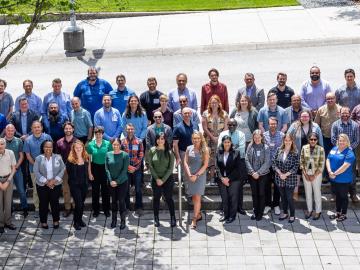
Filter News
Area of Research
- Advanced Manufacturing (3)
- Biological Systems (1)
- Biology and Environment (38)
- Clean Energy (48)
- Computational Biology (1)
- Computational Engineering (1)
- Computer Science (2)
- Fuel Cycle Science and Technology (1)
- Fusion and Fission (8)
- Isotope Development and Production (1)
- Isotopes (7)
- Materials (103)
- Materials Characterization (1)
- Materials for Computing (12)
- Materials Under Extremes (1)
- National Security (46)
- Neutron Science (80)
- Nuclear Science and Technology (7)
- Quantum information Science (1)
- Supercomputing (70)
News Type
News Topics
- (-) Biomedical (47)
- (-) Clean Water (17)
- (-) Composites (18)
- (-) Cybersecurity (31)
- (-) Frontier (40)
- (-) Materials Science (103)
- (-) National Security (60)
- (-) Neutron Science (99)
- (-) Physics (58)
- 3-D Printing/Advanced Manufacturing (88)
- Advanced Reactors (19)
- Artificial Intelligence (79)
- Big Data (36)
- Bioenergy (75)
- Biology (82)
- Biotechnology (19)
- Buildings (36)
- Chemical Sciences (55)
- Climate Change (76)
- Computer Science (148)
- Coronavirus (35)
- Critical Materials (15)
- Decarbonization (68)
- Education (4)
- Element Discovery (1)
- Emergency (2)
- Energy Storage (76)
- Environment (145)
- Exascale Computing (35)
- Fossil Energy (5)
- Fusion (46)
- Grid (42)
- High-Performance Computing (72)
- Hydropower (5)
- Isotopes (46)
- ITER (4)
- Machine Learning (36)
- Materials (101)
- Mathematics (7)
- Mercury (9)
- Microelectronics (3)
- Microscopy (39)
- Molten Salt (3)
- Nanotechnology (46)
- Net Zero (11)
- Nuclear Energy (86)
- Partnerships (45)
- Polymers (23)
- Quantum Computing (30)
- Quantum Science (57)
- Renewable Energy (2)
- Security (23)
- Simulation (40)
- Software (1)
- Space Exploration (15)
- Statistics (2)
- Summit (51)
- Sustainable Energy (80)
- Transformational Challenge Reactor (7)
- Transportation (57)
Media Contacts
Joe Tuccillo, a human geography research scientist, leads the UrbanPop project that uses census data to create synthetic populations. Using a Python software suite called Likeness on ORNL’s high-performance computers, Tuccillo’s team generates a population with individual ‘agents’ designed to represent people that interact with other agents, facilities and services in a simulated neighborhood.

Two ORNL teams recently completed Cohort 18 of Energy I-Corps, an immersive two-month training program where the scientists define their technology’s value propositions, conduct stakeholder discovery interviews and develop viable market pathways.

Brian Sanders is focused on impactful, multidisciplinary science at Oak Ridge National Laboratory, developing solutions for everything from improved imaging of plant-microbe interactions that influence ecosystem health to advancing new treatments for cancer and viral infections.
The contract will be awarded to develop the newest high-performance computing system at the Oak Ridge Leadership Computing Facility.

Brittany Rodriguez never imagined she would pursue a science career at a Department of Energy national laboratory. However, after some encouraging words from her mother, input from key mentors at the University of Texas Rio Grande Valley, or UTRGV, and a lot of hard work, Rodriguez landed at DOE’s Manufacturing Demonstration Facility, or MDF, at Oak Ridge National Laboratory.

ORNL hosted the Mid-South Regional Chapter of the American Society for Photogrammetry and Remote Sensing, or ASPRS. Participants spanning government, academia and industry engaged in talks, poster sessions, events and workshops to further scientific discovery in a field devoted to using pictures to understand changes to the earth’s inhabitants and landscape.

Researchers conduct largest, most accurate molecular dynamics simulations to date of two million correlated electrons using Frontier, the world’s fastest supercomputer. The simulation, which exceed an exaflop using full double precision, is 1,000 times greater in size and speed than any quantum chemistry simulation of it's kind.

To better predict long-term flooding risk, scientists at the Department of Energy’s Oak Ridge National Laboratory developed a 3D modeling framework that captures the complex dynamics of water as it flows across the landscape. The framework seeks to provide valuable insights into which communities are most vulnerable as the climate changes, and was developed for a project that’s assessing climate risk and mitigation pathways for an urban area along the Southeast Texas coast.

A newly established internship between ORNL and Maryville College is bringing cybersecurity careers to a local liberal arts college. The internship was established by a Maryville College alumni who recently joined ORNL.

As a data scientist, Daniel Adams uses storytelling to parse through a large amount of information to determine which elements are most important, paring down the data to result in the most efficient and accurate data set possible.


